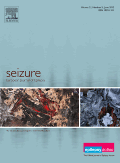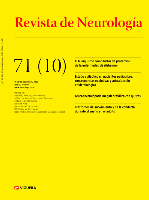
Journal of Pediatric Epilepsy
Scope & Guideline
Advancing knowledge for brighter futures in pediatric epilepsy.
Introduction
Aims and Scopes
- Pediatric Epilepsy Syndromes:
The journal emphasizes the classification, diagnosis, and treatment of various pediatric epilepsy syndromes, including self-limited syndromes and genetic epilepsies. - Clinical Case Studies:
It publishes detailed case reports that provide insights into rare or atypical presentations of pediatric epilepsy, contributing to the clinical knowledge and experience in managing such cases. - Neurophysiological Assessments:
The use of electroencephalography (EEG) and other neurophysiological techniques is a core focus, highlighting their role in diagnosing and managing epilepsy in children. - Treatment Efficacy and Safety:
Research on the efficacy and safety of various antiepileptic drugs and treatment modalities, including surgical interventions, is a significant area of interest. - Multidisciplinary Approaches:
The journal supports the integration of various disciplines such as neurology, psychology, and neuropsychopharmacology to provide comprehensive care and treatment strategies for pediatric patients. - Quality of Life and Family Impact:
Research addressing the psychosocial aspects of pediatric epilepsy, including parental concerns and quality of life assessments, is also a priority.
Trending and Emerging
- Genetic Epilepsies:
An increasing number of studies are focusing on genetic etiologies of epilepsy, reflecting advances in genetic testing and understanding of epilepsy syndromes. - Minimally Invasive Surgical Techniques:
There is a growing emphasis on minimally invasive approaches to epilepsy surgery, as evidenced by multiple studies on techniques like stereoelectroencephalography, indicating a shift towards less invasive treatment options. - Impact of COVID-19 on Epilepsy Management:
Research examining the implications of the COVID-19 pandemic on epilepsy treatment and care has increased, highlighting the need for adaptations in clinical practice during health crises. - Neuropsychological Aspects:
Emerging studies are increasingly addressing the neuropsychological impacts of epilepsy on children, including anxiety, depression, and overall psychological well-being. - Quality Improvement Initiatives:
The journal is witnessing a trend towards quality improvement studies aimed at enhancing care protocols for pediatric epilepsy, indicating a focus on improving healthcare delivery.
Declining or Waning
- Generalized Epilepsy Studies:
Research specifically focused on generalized epilepsy has decreased, possibly as the field shifts towards more nuanced understandings of focal epilepsies and their management. - Historical Case Reports:
There has been a noticeable decline in the publication of historical or retrospective case reports, as the journal increasingly prioritizes contemporary studies and clinical advancements. - Social and Economic Challenges:
Papers exploring the socioeconomic barriers to epilepsy care are less common, indicating a potential shift in focus towards direct clinical and treatment-related research.
Similar Journals

BRAIN & DEVELOPMENT
Illuminating Pathways in Developmental NeurologyBRAIN & DEVELOPMENT is a prestigious academic journal published by ELSEVIER, renowned for its pivotal contributions to the fields of developmental neuroscience, neurology, and pediatrics. Established in 1979, this journal has become an essential resource for researchers and clinicians alike, as it explores the complexities of brain development and associated neurological disorders in children. With an impactful focus on advancing scientific understanding, BRAIN & DEVELOPMENT is currently ranked in the Q3 quartile in Developmental Neuroscience and Clinical Neurology and Q2 in Pediatrics, reflecting its significance within the medical community. Its ISSN 0387-7604 and E-ISSN 1872-7131 underline its established presence in academic literature. While the journal does not offer open access options, it continues to be a key platform for disseminating new research findings and fostering innovation in the understanding of pediatric neurological health. The journal's commitment to quality research is further evidenced by its ongoing publication trajectory up until 2024, making it a vital source of knowledge for students, professionals, and educators in related fields.

Epilepsi
Elevating the conversation around epilepsy through open access.Epilepsi is an esteemed academic journal dedicated to advancing the field of epilepsy research and treatment, published by KARE PUBL. With its open access model established since 2017, the journal ensures that vital research findings are easily accessible to a global audience, thereby fostering collaboration and knowledge sharing among researchers, healthcare professionals, and students. The journal focuses on a comprehensive range of topics within neurology, including clinical studies, therapeutic advancements, and innovative approaches to epilepsy management. Located in Istanbul, Turkey, Epilepsi aims to bridge the gap between research and practice, enhancing understanding and patient care for individuals affected by epilepsy. Its commitment to high-quality, peer-reviewed content makes it a significant resource for anyone involved in epilepsy research or clinical practice.

Case Reports in Pediatrics
Empowering Healthcare Professionals with Real-World Pediatric Cases.Case Reports in Pediatrics is a distinguished journal dedicated to the publication of high-quality case reports that illuminate specific pediatric clinical challenges and advancements. Published by HINDAWI LTD, this journal has established itself as an essential resource in the field of pediatric medicine, offering an open-access platform since 2011 to ensure that researchers, healthcare professionals, and students have unrestricted access to valuable insights. With an ISSN of 2090-6803 and an E-ISSN of 2090-6811, the journal aims to foster knowledge exchange and further the understanding of pediatric healthcare practices. This publication not only encourages the sharing of unique and rare case studies but also promotes best practices and innovative methodologies. In a rapidly evolving field, Case Reports in Pediatrics serves as a vital tool for professionals seeking to enhance patient care and inform clinical decision-making.

NEUROPEDIATRICS
Exploring the frontiers of children's neurological health.NEUROPEDIATRICS is a prominent academic journal published by GEORG THIEME VERLAG KG, dedicated to advancing the understanding and treatment of neurological disorders in children. Established in 1980, this journal has consistently provided a platform for innovative research and clinical practice in the fields of pediatrics and neurology, culminating in its recognition across various rankings; it holds a Q2 rating in Pediatrics, Perinatology and Child Health, and Q3 in both Medicine (miscellaneous) and Neurology (clinical) as of 2023. While NEUROPEDIATRICS is not an open access journal, it remains a crucial resource for researchers, clinicians, and students who seek cutting-edge insights and evidence-based practices in the management of pediatric neurological issues. As a result, NEUROPEDIATRICS plays an indispensable role in shaping future research directions and improving health outcomes in this vital field.

Case Reports in Oncological Medicine
Connecting research and practice in oncological medicine.Case Reports in Oncological Medicine is a distinguished open-access journal published by HINDAWI LTD, dedicated to disseminating valuable insights and findings in the field of oncology. Since its inception in 2011, this journal has aimed to provide a unique platform for the publication of detailed case reports that contribute to our understanding of cancer diagnosis, treatment, and management. With a specific focus on sharing clinical experiences and outcomes, it seeks to engage researchers, healthcare professionals, and students who are committed to advancing oncological knowledge and improving patient care. Although coverage in Scopus was discontinued from 2014 to 2017, the journal currently holds a rank of #232/323 in Medicine - Oncology, placing it within the 28th percentile. Researchers interested in making their work accessible can benefit from the journal's open-access model, allowing greater visibility and citation potential within the scientific community. The journal is positioned as an important resource for those looking to stay updated on the latest case studies and innovations in oncological medicine.

SEIZURE-EUROPEAN JOURNAL OF EPILEPSY
Connecting academia and clinical practice in neurology.SEIZURE - EUROPEAN JOURNAL OF EPILEPSY is a leading journal published by W B SAUNDERS CO LTD, specializing in the field of epilepsy and seizure disorders. Since its inception in 1992, this journal has committed itself to advancing research and understanding in neurology, achieving a respectable 2023 impact factor reflected by its Q2 rankings in Medicine (miscellaneous), Neurology, and Clinical Neurology categories. With an impressive Scopus ranking that places it in the top 35% of journals in Neuroscience and Neurology, SEIZURE is dedicated to promoting high-quality research and clinical studies that offer insights into epilepsy management and treatment. Although not an open-access journal, it maintains a diverse array of original articles, reviews, and case studies catering to academicians, medical professionals, and students looking to expand their knowledge on epilepsy. This journal is pivotal for those seeking to stay abreast of the latest trends, therapies, and findings in the neuroclinical landscape.

REVISTA DE NEUROLOGIA
Bridging Research and Application in NeurologyREVISTA DE NEUROLOGIA is a distinguished academic journal focusing on the broad fields of neurology and medicine, published in Spain since its inception in 1959. The journal plays a vital role in disseminating significant research findings, clinical studies, and advancements in neurological science, catering to an audience of researchers, clinicians, and students alike. With an ISSN of 0210-0010 and an E-ISSN of 1576-6578, this quarterly publication has maintained its commitment to enhancing the understanding of neurological disorders and therapies through rigorous peer-reviewed articles. While currently not classified as open access, it is indexed in Scopus, holding a rank of #253 out of 400 in the category of Medicine (Neurology), reflecting its relevance in the field with a 36th percentile. The journal is positioned within the Q3 quartile for both Medicine (miscellaneous) and Clinical Neurology categories as of 2023. Based in Barcelona, Spain, it is a vital resource for anyone devoted to the advancement of knowledge and practice in neurology.

EPILEPSY & BEHAVIOR
Innovating insights into epilepsy and behavioral disorders.EPILEPSY & BEHAVIOR is a premier journal dedicated to advancing the field of neurology and behavioral neuroscience, published by Academic Press Inc. Elsevier Science. With a focus on the complex interplay between epilepsy and behavioral disorders, this journal serves as a pivotal platform for researchers, clinicians, and educators alike. The journal holds a commendable position with a Q2 ranking in key categories such as Behavioral Neuroscience and Clinical Neurology, highlighting its influence and contributions to the scientific community. Notably, EPILEPSY & BEHAVIOR is indexed in Scopus, ranking in the top percentiles across various related fields, which underscores the quality and relevance of the research it publishes. As it navigates from its inception in 2000 to its ongoing work into 2024, the journal remains committed to disseminating high-quality research and insights that address critical issues in epilepsy and associated behavioral challenges, providing invaluable resources for ongoing education and innovation in the field.

Clinical Epileptology
Fostering interdisciplinary dialogue in epilepsy care.Clinical Epileptology, published by Springer Heidelberg, is an emerging open-access journal that aims to advance the understanding of epilepsy through rigorous research and clinical studies. With an ISSN of 2948-104X and E-ISSN of 2948-1058, this journal serves as a vital platform for researchers, clinicians, and students within the fields of Neurology, Pediatrics, and Perinatology. Although still in its formative years, spanning from 2023 to 2024, the journal aspires to fill the knowledge gaps in epilepsy research, thereby improving patient outcomes. Despite its initial Scopus rankings placing it within the 12th and 19th percentiles in respective categories, Clinical Epileptology is poised to make a significant impact by fostering interdisciplinary collaboration and disseminating high-quality findings. With options for open access, this journal ensures that groundbreaking research is readily available to a global audience, encouraging the ongoing dialogue that is crucial to advancing the field. Intended for a diverse readership, including academic researchers, healthcare professionals, and students, Clinical Epileptology is committed to becoming a cornerstone of epilepsy research.

Annals of Indian Academy of Neurology
Championing High-Quality Research in Indian NeurologyAnnals of Indian Academy of Neurology is a premier open access journal dedicated to advancing the field of Neurology, serving as a vital resource for researchers, healthcare professionals, and students since its inception in 2006. Published by the esteemed Wolters Kluwer Medknow Publications, this journal has established itself within the academic community, boasting a Q3 quartile ranking in clinical neurology according to the 2023 category quartiles and a Scopus rank placing it in the 35th percentile among 400 comparable journals. With a focus on clinical advancements and research innovations in neurology, the journal aims to disseminate high-quality and impactful studies that address the complex challenges faced in the neurological landscape, particularly within the Indian context. The open access model ensures that the latest research is readily accessible to a global audience, thereby promoting collaboration and knowledge sharing within the neurosciences.